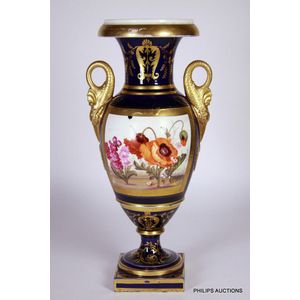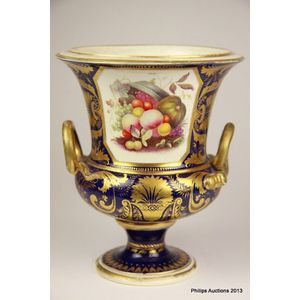Cobalt Blue Derby Vase with Fruit Panel
You must be a subscriber, and be logged in to view price and dealer details.
Subscribe Now to view actual auction price for this item
When you subscribe, you have the option of setting the currency in which to display prices to $Au, $US, $NZ or Stg.
- Anthemion - An anthemion is a classical decorative design element based on the acanthus flower that consists of a central circular or oval motif surrounded by radiating petals or leaves. It is often used as a border or frieze in architecture, furniture, and other decorative arts. The anthemion is derived from the palmette, a motif that was popular in ancient Greek and Roman art and architecture. It is often associated with the classical world and with Neoclassical style, and it is often used to add a sense of grandeur and formality to a design. The anthemion is also known as a honeysuckle or honeysuckle ornament. It continues to be used in a variety of contexts today, and it is often admired for its elegant and decorative qualities.
- Campana Form Vases or Urns - A campana form vase or urn is a type of ceramic or metal container that is characterized by its reverse bell-like shape. The shape is typically wider at the top and narrower at the bottom, with a curved or flared opening at the top. The vase or urn may have a handle or handles on either side of the opening.The campana form was popular in ancient Greece and Rome, and the design has been revived in various forms throughout the history of art, including the Renaissance and the Art Nouveau period.
- Circa - A Latin term meaning 'about', often used in the antique trade to give an approximate date for the piece, usually considered to be five years on either side of the circa year. Thus, circa 1900 means the piece was made about 1900, probably between 1895 and 1905. The expression is sometimes abbreviated to c.1900.
- Acanthus - A stylized leaf motif, one of the primary decorative elements of classical Greek and Roman architecture, derived from the genus of flowering plants in the family Acanthaceae, native to tropical and subtropical regions of the Mediterranean area. It is a common element in classical Greek and Roman design, and is often seen in Corinthian and Composite order columns and used as a decorative element in English, European and Australian furniture, particularly on the curve of a leg, and as decoration for a corbel.
This item has been included into following indexes:
Visually similar items

Antique Paris porcelain style urn, 26 cm high

A painted and gilt blue ground porcelain urn, probably Derby, circa 1820. 21 cm high

A Derby porcelain urn, circa 1820s, the campana urn with lion's head bracket handles raised on a pedestal foot, decorated with well painted mostly rose bouquets within gilt embellished cartouches upon a deep blue mottled ground, unmarked. Height 17.5 cm

A Grainger Lee & Co Worcester pedestal vase, circa 1815-20, the elegant Empire style vase with finely moulded dolphin handles and anthemion mounts, with a framed painted plaque of oriental poppies and stocks, upon a cobalt ground richly gilded with borders
